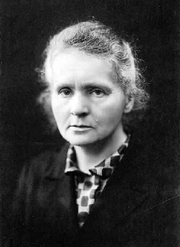
Marie Skłodowska-Curie (7 November 1867 – 4 July 1934) was a Polish physicist and chemistfamous for her pioneering research on radioactivity. She was the first person honored with two Nobel Prizes—in physics and chemistry. She was the first female professor at the University of Paris, and in 1995 became the first woman to be entombed on her own merits in the Panthéon in Paris.
She was born Maria Salomea Skłodowska ([ˈmarja salɔˈmɛa skwɔˈdɔfska]) in Warsaw, in what was then the Kingdom of Poland. She studied at Warsaw's clandestine Floating University and began her practical scientific training in Warsaw. In 1891, aged 24, she followed her older sister Bronisława to study in Paris, where she earned her higher degrees and conducted her subsequent scientific work. She shared her 1903 Nobel Prize in Physics with her husband Pierre Curie and with the physicist Henri Becquerel. Her daughter Irène Joliot-Curie and son-in-law, Frédéric Joliot-Curie, would similarly share a Nobel Prize. She was the sole winner of the 1911 Nobel Prize in Chemistry. Skłodowska-Curie was the first woman to win a Nobel Prize, the only woman to date to win in two fields, and the only person to win in multiple sciences.
Her achievements included a theory of radioactivity (a term that she coined), techniques for isolating radioactive isotopes, and the discovery of two elements, polonium and radium. Under her direction, the world's first studies were conducted into the treatment of neoplasms, using radioactive isotopes. She founded the Curie Institutes in Paris and Warsaw, which remain major centres of medical research today.
While an actively loyal French citizen, Skłodowska-Curie (she used both surnames) never lost her sense of Polish identity. She taught her daughters the Polish language and took them on visits to Poland. She named the first chemical element that she discovered – polonium, which she first isolated in 1898 – after her native country. During World War I she became a member of the Committee for a Free Poland (Komitet Wolnej Polski). In 1932, she founded a Radium Institute (now the Maria Skłodowska–Curie Institute of Oncology) in her home town, Warsaw, headed by her physician-sister Bronisława. Curie died in 1934 of aplastic anemia brought on by her years of exposure to radiation.

